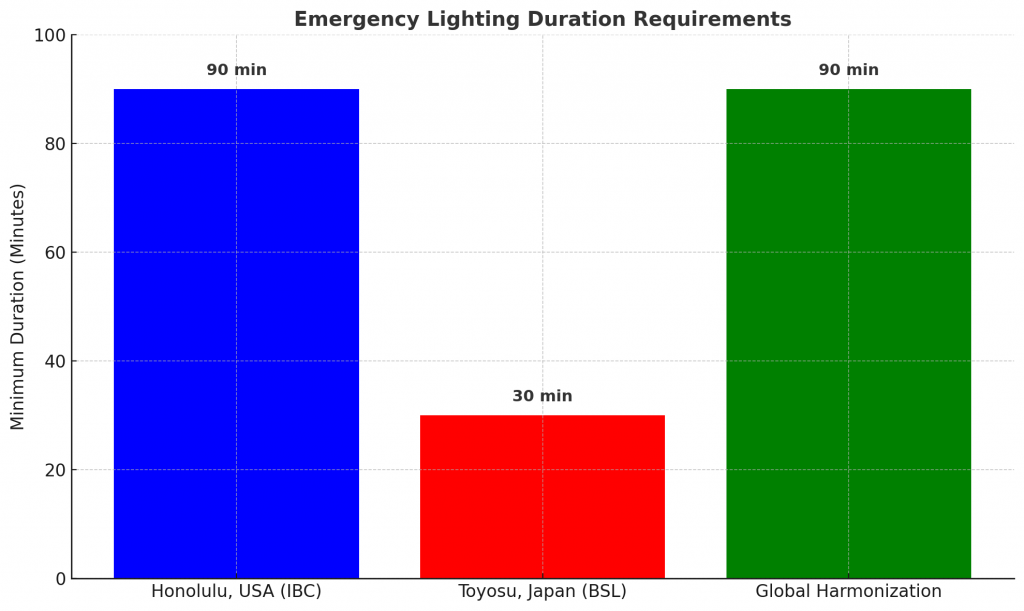General Definitions:
- IBC (International Building Code, USA):
- Section 1008.3 requires emergency lighting for all egress routes, including stairways, aisles, corridors, exit passageways, and other components of the means of egress.
- The lighting must be automatically activated upon power loss and provide a minimum illumination level for at least 90 minutes.
- BSL (Building Standard Law, Japan):
- Article 28 mandates emergency lighting in all business-use buildings to ensure that occupants can safely evacuate during fire or power outages.
- The lighting is required in staircases, corridors, and principal paths of travel.
Comparison Table:
| Criterion | IBC (USA) | BSL (Japan) |
| Emergency Lighting Requirement | Required for all egress routes | Required in all business-use buildings |
| Basis for Requirement | Path of egress (corridors, stairs, exit paths) | Building occupancy classification |
| Scope of Application | Applies to any path leading to an exit | Applies to all main egress paths in business buildings |
| Compliance and Enforcement | Local inspections per IBC 1008.3 | Enforced nationally under BSL Article 28 |
| Minimum Duration Requirement | 90 minutes minimum | 30 minutes minimum (typical under JIS standards) |
| Testing and Certification | NFPA 101, UL 924 | Japanese Industrial Standards (JIS) |
Key Differences:
- IBC: Targets all components of the egress system with specific minimum performance durations.
- BSL: Applies broadly to business buildings with slightly shorter required illumination duration.
Case Study:
5-Story Office Building
- Honolulu, USA (IBC):
- Emergency Lighting: Required in stairways, corridors, exits, and all egress paths with 90 minutes of operation.
- Toyosu, Japan (BSL):
- Emergency Lighting: Required throughout the building’s egress paths with at least 30 minutes of backup lighting.

Global Approach:
- Unified Lighting Duration Standards:
- Set global minimums of 30 minutes and mandate 90 minutes for high-rise and assembly occupancies.
- Functional and Risk-Based Guidelines:
- Adapt duration and placement of emergency lighting to egress risk profiles and building height.
- Combined Testing Protocols:
- Harmonize UL 924 and JIS emergency lighting standards into one global certification benchmark.
- Training and Simulation Exercises:
- Implement international best practices through training for system designers and safety officials.
- Periodic Review and Innovation Integration:
- Update emergency lighting protocols regularly to reflect new battery technologies and smart system integration.
IBC Section 1008.3 – Emergency Power for Illumination
| Section | Title | Requirement Summary |
|---|---|---|
| 1008.3 | Emergency Power for Illumination | Emergency lighting must be provided for certain occupancies and locations when normal power fails. |
| 1008.3.1 | Duration | Emergency lighting must remain on for a minimum of 90 minutes after power failure. |
| 1008.3.2 | Power Source | Emergency lighting must be powered by storage batteries, onsite generator, or approved alternate. |
| 1008.3.3 | Test and Maintenance | Emergency lighting systems must be maintained operational and tested periodically per code. |
| 1008.3.4 | Locations Requiring Emergency Lighting | Emergency lighting must be provided in: |
| – Exit access corridors, aisles, and stairways | Areas serving as means of egress. | |
| – Electrical rooms | Where equipment rated 1,000 amperes or more and over 6 feet wide is located. | |
| – Fire command centers | As required by Section 911. | |
| – Fire pump rooms | As required by Section 913. | |
| – Elevator machine rooms, control rooms | Where standby power is required. | |
| – Areas for high-rise building operations | Including standby/emergency systems as per Sections 403 and 911. |
Key Observations:
- Operational Duration: The IBC mandates a 90-minute operation period for emergency lighting, whereas the BSL requires over 30 minutes.
- Activation Time: The BSL specifies a maximum of 40 seconds to achieve operational voltage for emergency systems; the IBC emphasizes immediate activation.
- Regulatory Oversight: In Japan, emergency lighting falls under the purview of both the Building Standard Law and the Fire Services Act, indicating a dual-layered regulatory approach.
| Category | IBC (International Building Code – 2018) | BSL (Japanese Building Standard Law) |
|---|
| Scope | Applies to buildings that require lighting for exit paths during blackouts. | Applies to buildings that must provide emergency lighting for safety. |
| Duration | Lighting must last at least 90 minutes. | Lighting must last more than 30 minutes. |
| Power Source | May use batteries, generators, or other approved systems. | Must use backup power to operate lighting and exhaust systems. |
| Activation Time | Must turn on immediately when power fails. | Must reach operating voltage within 40 seconds of power loss. |
| Testing & Maintenance | Must be regularly tested and maintained. | Requires routine inspection and reporting to authorities. |
| Regulatory Basis | Covered under IBC Section 1008.3. | Regulated by the BSL and the Fire Services Act. |
